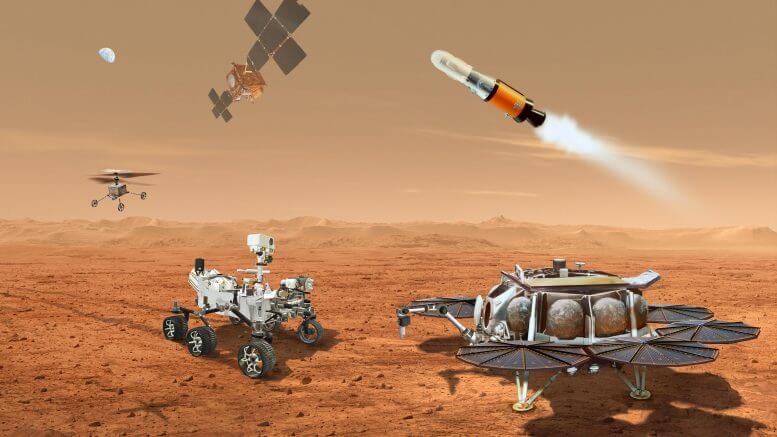In addition to bringing the first sample collected from Mars to Earth, this very complex mission will include the first launch from the soil of another planet, and also the first rendezvous in orbit around another planet. The return of the samples from Mars is a partnership with the European Space Agency
This illustration shows an idea of several robots that would be connected to bring to Earth samples collected from the surface of Mars by NASA's Mars rover Perseverance. Credit: NASA/JPL-Caltech

Last week a capsule successfully landed containing samples collected fromThe asteroid was captured by the Osiris-Rex spacecraft, but NASA has a much more ambitious sample return mission - from Mars.
An independent review board has reviewed the current plans and goals for NASA's first Mars sample return mission, and NASA is establishing a team to respond.
In addition to bringing the first sample collected from Mars to Earth, this very complex mission will include the first launch from the soil of another planet, and also the first rendezvous in orbit around another planet. Returning the samples from Mars It is a partnership with ESA (European Space Agency).
"NASA has plans for a robust Moon-to-Mars exploration approach," said Nicola Fox, NASA's deputy administrator for science. "Mars is a rich target for scientific exploration, and understanding the Red Planet supports our Artemis plan to eventually send people to Mars."
NASA and the European Space Agency are developing plans for one of the most ambitious operations ever attempted in space: bringing the first samples of Martian material safely back to Earth for detailed study. The diverse group of scientifically preserved samples now being collected by the Mars rover Perseverance could help scientists answer the question of whether ancient life ever appeared on the Red Planet.
The committee delivered its report to NASA earlier this month, noting the scientific importance of the mission but expressing concerns about the mission's budget, among other areas. After an assessment that lasted two months, the committee gave NASA a report with 20 findings and 59 recommendations.
"The return of the samples from Mars is a very complex plan and operation with many parallel developments, interfaces and complexities," said Orlando Figueroa, chairman of the independent inspection committee. "The development of this historic activity comes after decades of strategic investment."
NASA established the investigative committee in May 2023 to evaluate the technical and cost plans and schedule before approving the mission's design. The committee will consult a wide range of NASA and external experts to understand the scope and management, technical approach, schedule and funding profile of the program.
In response to the report, NASA formed a team - led by Sandra Connelly, NASA's deputy assistant administrator for science - to examine it. The team will provide recommendations by the second quarter of fiscal year 2024 regarding a path forward for the return of the samples from Mars within a balanced overall science program. NASA will delay its plans to confirm the program's official cost and schedule until after that review is complete.
"An independent inspection committee like the one we established for the return of the samples from Mars helps to examine whether we are on the right track to meeting our mission goals within the allocated budget," said Connelly. "We thank the committee for its work, and now we must evaluate the report and respond if there are elements of the plan that need to be changed."
It should be noted that stones from Mars reached Earth only as a result of the collision of asteroids that threw them into space and eventually landed on Earth.
More of the topic in Hayadan:
- A meteorite from Mars landed in Morocco
- The Invasion of Mars - Part II
- From Mars to Jupiter and back
- Planets in Planter
- A new meteorite from Mars has been discovered
#NASA #Mars #sample_return #space #space_exploration #Mars_mission #sample_return_mission
